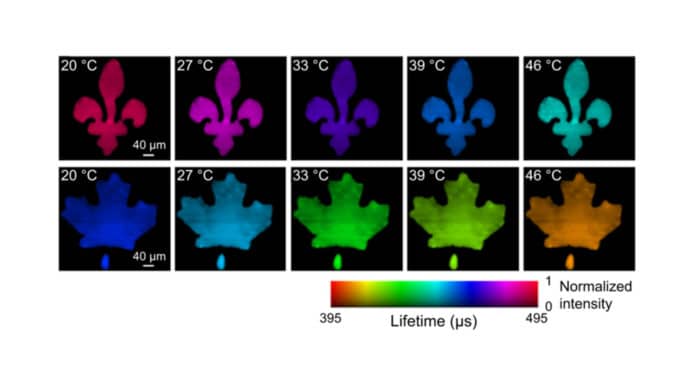The teams of Professors Jinyang Liang and Fiorenzo Vetrone at the Institut national de la recherche Scientifique (INRS) have developed a new imaging technique that can measure temperature in 2D in just a snap, that too without contact. This technique could potentially improve photothermal therapy and help in the early diagnosis of skin cancers.
Scientists dubbed this technology as single-shot photoluminescence lifetime imaging thermometry (SPLIT). Developed from a compressed-sensing ultrahigh-speed imaging paradigm, SPLIT technology first records wide-field luminescence intensity decay compressively in two views in a single exposure.
It is mainly based on the luminescence of nanoparticles doped with rare-earth ions.
Professor Fiorenzo Vetrone, a pioneer in this field of study, said, “They are considered as nanothermometers because their luminescent properties change with the temperature of the environment. They are also biocompatible.”
Xianglei Liu, a Ph.D. student at INRS and the lead author of this article, said, “Instead of imaging the luminescence point by point, which is time-consuming, SPLIT uses a novel ultrahigh-speed camera to track how quickly the luminescence decays of these nanoparticles in every spatial point.”
“Our camera is different from a common one, where each click gives one image: our camera works by capturing all the images of a dynamic event into one snapshot. Then we reconstruct them, one by one.”
Professor Liang said, “The temperature can then be sensed by checking how fast the emitted light fades out. Since it is in real-time, SPLIT can follow the phenomenon as it happens. For the first time, it enables the luminescence thermometry using the nanoparticle’s lifetime with a moving sample.”
“Compared to existing thermometry techniques, SPLIT is faster and has higher resolution. This allows a more accurate temperature sensing with both an advanced and economical solution.”
According to scientists, this SPLIT technology could one day detect and treat skin cancers.
Professor Liang said, “SPLIT marks an important step in the technical development. With high resolution, the technology could be used to precisely locate the cancerous mole.”
It could also be used to monitor the light dose during certain types of treatment. For example, photothermal therapy attacks cancer cells through the heat generated by exposure to near-infrared light.
Vetrone said, “We want to eradicate cancer, but not the surrounding tissue, so if the temperature is too high, the treatment could be decreased or stopped for a while. If it’s too low, we can increase the light to get the right dose.”
Journal Reference:
- Liu, X., Skripka, A., Lai, Y. et al. Fast wide-field upconversion luminescence lifetime thermometry enabled by single-shot compressed ultrahigh-speed imaging. Nat Commun 12, 6401 (2021). DOI: 10.1038/s41467-021-26701-1
